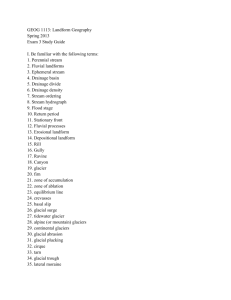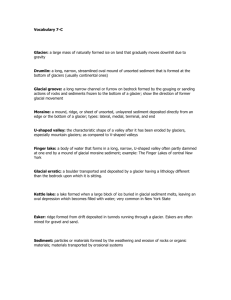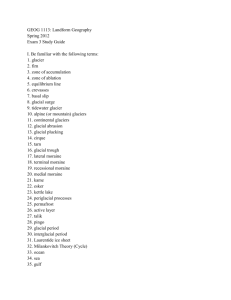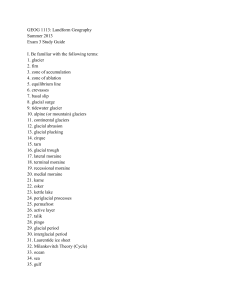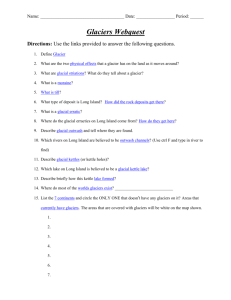Glacial_Matrix
advertisement
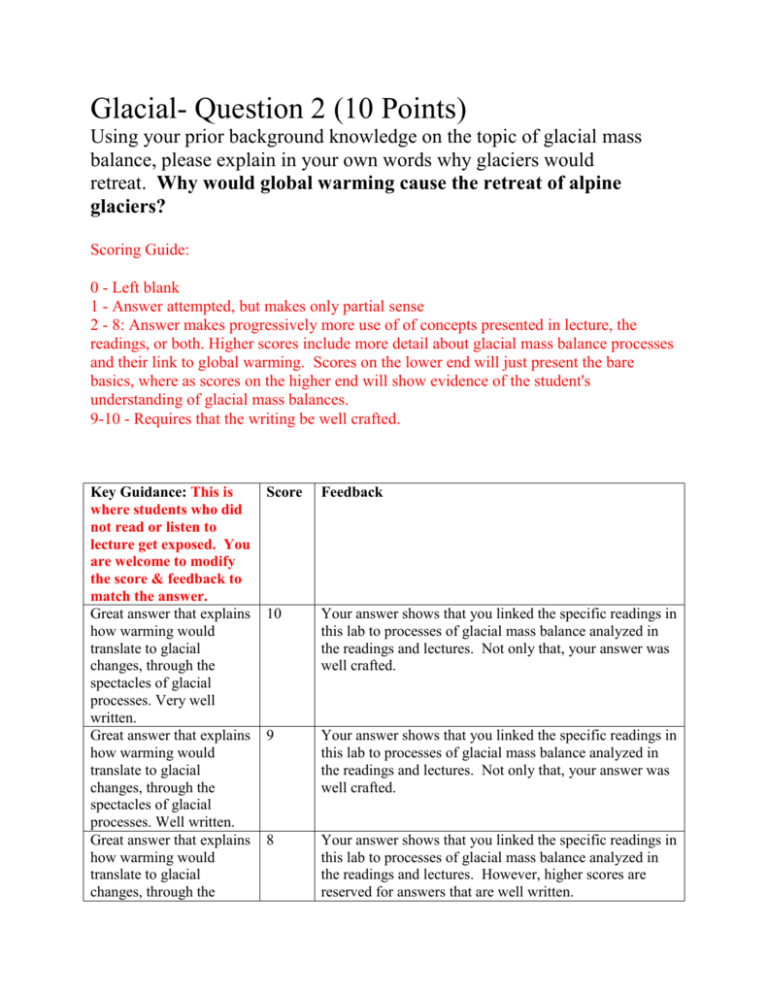
Glacial- Question 2 (10 Points) Using your prior background knowledge on the topic of glacial mass balance, please explain in your own words why glaciers would retreat. Why would global warming cause the retreat of alpine glaciers? Scoring Guide: 0 - Left blank 1 - Answer attempted, but makes only partial sense 2 - 8: Answer makes progressively more use of of concepts presented in lecture, the readings, or both. Higher scores include more detail about glacial mass balance processes and their link to global warming. Scores on the lower end will just present the bare basics, where as scores on the higher end will show evidence of the student's understanding of glacial mass balances. 9-10 - Requires that the writing be well crafted. Key Guidance: This is where students who did not read or listen to lecture get exposed. You are welcome to modify the score & feedback to match the answer. Great answer that explains how warming would translate to glacial changes, through the spectacles of glacial processes. Very well written. Great answer that explains how warming would translate to glacial changes, through the spectacles of glacial processes. Well written. Great answer that explains how warming would translate to glacial changes, through the Score Feedback 10 Your answer shows that you linked the specific readings in this lab to processes of glacial mass balance analyzed in the readings and lectures. Not only that, your answer was well crafted. 9 Your answer shows that you linked the specific readings in this lab to processes of glacial mass balance analyzed in the readings and lectures. Not only that, your answer was well crafted. 8 Your answer shows that you linked the specific readings in this lab to processes of glacial mass balance analyzed in the readings and lectures. However, higher scores are reserved for answers that are well written. spectacles of glacial processes. Written adequately Great answer that explains how warming would translate to glacial changes, through the spectacles of glacial processes. Written poorly. Answer sort of explains how warming would translate to glacial changes, through the spectacles of glacial processes. Written poorly. 6 4 Very minimal answer. 2 Nothing uploaded 0 Your answer shows that you linked the specific readings in this lab to processes of glacial mass balance analyzed in the readings and lectures. However, your writing needs to be better crafted. It is critical that you proof-read your writing. One way to do this is to read what you wrote out loud. Your answer dances around how global warming would cause the retreat of mountain glaciers, however the scoring guide indicated that you really needed to go into detail on glacial processes and how the mass balance of the glacier works. Also However, your writing needs to be better crafted. It is critical that you proof-read your writing. One way to do this is to read what you wrote out loud. This essay forms one-tenth of all of the points in the lab. It sets up the entire activity by asking you to review lecture and reading materials about how glaciers work. You take that knowledge and analyze readings related to the general issue of global warming. Your answer really did not engage the question with any depth. Your answer was left blank. Glacial- Question 3 (4 Points) After reading each article, please finish a scientific hypothesis for what Hecht and Pelto would expect to find if they examined 150 years of historical records of maps and photos of one glacial system in the Cascades of the Pacific Northwest USA. (4 points) Scoring Guide for Each Hypothesis: 0 - not attempted or makes little sense 1- student presents a only a partially correct summary of the author's position 2 - student presents a clear and correct summary of the author's position Hecht’s Hypothesis: A glacial system in the Cascades of the Pacific Northwest USA has been ... Pelto’s Hypothesis: A glacial system in the Cascades of the Pacific Northwest USA has been ... JUST SCORE THIS -- Almost all of the students will get full points. If the student messes up, just use the scoring guide as the feedback Glacial- Question 4 (4 Points) Scoring guide: 0 - left blank or wording so unclear as to be not understood + 2 points for each hypothesis, where the hypothesis is well written and is reasonable What is your hypothesis? Finish the two sentences (4 points). I hypothesize that, over the last 150 years, … I also hypothesize that this has been caused by …. JUST SCORE THIS -- Almost all of the students will get full points. If the student messes up, it will be by leaving one of the hypotheses blank … So the typical feedback would be 4 – Your hypotheses are reasonable. 2 – You missed completing one of the hypotheses Glacial- Question 5 (15 Points) The red values are given to the students. So there are 15 rows so 1 point per row. Note 1: accept any confidence ranking, but the column must be filled out for full points in a row. Note 2: The length of Nisqually is what is being graded. yr Your Confidence ( high-1, medium-2, low-3, very low-4) Length of Nisqually Glacier in Kilometers (subtract distance from bridge from 8.8 kilometer distance from summit of Mount Rainier) 1856 Any is ok, but must be filled in for full credit Accept 7 to 11 km 1907 Any is ok, but 8.8 km must be filled in for full credit 1917 Any is ok, but must be filled in for full credit 1924 Any is ok, but Accept 7 to 8.8 km must be filled in for full credit 1929 Any is ok, but Accept 4 to 8 km must be filled in for full credit 1940 Any is ok, but Accept 4 to 8 km must be filled in Accept 7 to 8.8 km for full credit 1943 Any is ok, but Accept 4 to 8 km must be filled in for full credit 1951 Any is ok, but Accept 4 to 8 km must be filled in for full credit 1956 Any is ok, but Accept 4 to 8 km must be filled in for full credit 1958 Any is ok, but Accept 4 to 8 km must be filled in for full credit 1960 Any is ok, but Accept 4 to 8 km must be filled in for full credit 1966 Any is ok, but Accept 4 to 8 km must be filled in for full credit 1969 Any is ok, but Accept 4 to 8 km must be filled in for full credit 1971 Any is ok, but 6.9 km must be filled in for full credit 1983 Any is ok, but Accept 5.5 to 8 must be filled in for full credit 1994 Any is ok, but Accept 6 to 8 must be filled in for full credit 1997 Any is ok, but Accept 6 to 8 must be filled in for full credit 2003 Any is ok, but 7.4 km must be filled in for full credit Glacial- Question 6 (5 Points) Explain your confidence ranking. The answer does not have to be detailed, but your answer must be based on your observations of looking at the maps and photos. 5 - The answer explains the student's thinking for all four of the scoring ranks, where the reasoning is based on observations made. In other words, the student uses examples to justify each of their rankings. Half point off for explaining the ranking, but not giving an example. 4 - The answer explains the student's thinking for 3 of the scoring ranks, where the reasoning is based on observations made. In other words, the student uses examples to justify each of their rankings. Half point off for explaining the ranking, but not giving an example. 3- The answer explains the student's thinking for 2 of the scoring ranks, where the reasoning is based on observations made. In other words, the student uses examples to justify each of their rankings. Half point off for explaining the ranking, but not giving an example. 2- The answer explains the student's thinking for 1 of the scoring ranks, where the reasoning is based on observations made. In other words, the student uses examples to justify each of their rankings. Half point off for explaining the ranking, but not giving an example. 1- Student presents a general explanation but does not go into specifics. 0 - The answer is left blank or it makes no sense. Key Guidance: Be lenient in grading. Answer explains confidence intervals. Explains 3 ranks Explains 2 ranks Explains 1 rank Score Feedback 5 Nice job! 4 3 2 Answer is just very general and vague. Writing was very confusing 1 You didn’t explain one of your rankings. You didn’t explain two of your rankings I wish you had explained all of the rankings. You just explained one. Your answer is too vague. The scoring guide indicates that you need to explain all of your rankings Your answer just could not be understood. Please read it again yourself. I really could not figure out what you were saying. Left blank 0 0 Glacial- Question 7 (10 Points) 10 - plot includes all of the data points from the table correctly place; plot connects the data points of only those ranked as medium or high confidence (3 or 4 in the data table) -5 points off for connecting all of the data points, regardless of their confidence -0.5 points off for either misplacing or missing a data point -0.5 points off for incorrectly connecting a low or very low confidence data in the line The big screw-up that students make is by connecting ALL of the data points. They are supposed to just plot the low confidence points (3&4) and connect the dots of the higher confidence points (1&2). So … the typical grading will be Key Guidance: Be lenient in grading. If you take off half points, just explain what you took off and why in the feedback. Everthing plotted okay ALL of the points are connected. Score Feedback 10 5 Nice job! The instructions and the scoring guide indicate that you should only connect the data points for data you yourself ranked as a 1 or 2 (medium or high confidence). Did not load up the plot 0 Glacial- Question 8 (5 Points) Are there similarities and differences between the plot of "Glacier X" glacier length and Global Temperature? Puget Sound Temperature? Scoring Guide: 0- left blank or answer written so poorly that we could not understand 1 - answer seems reasonable, but answer does not explicitly link the graph that the student prepared to the global and Puget sound temperature curves 2 - answer is reasonable and explicitly links the graph that the student prepared to one of the temperature records 3 - answer is reasonable and explicitly links the graph that the student prepared to both of the temperature records 4 - answer is reasonable, explicitly links the graph that the student prepared to both of the temperature records, and discusses similarities and differences in one of the temperature records 5 - answer is reasonable, explicitly links the graph that the student prepared to both of the temperature records, and discusses similarities and differences in both of the temperature records Key Guidance: Be lenient in grading. What’s important is that they explain their answer with an example or two The answer explicitly links their plot to BOTH temperature records and discusses similarities and differences between their plot and BOTH temperature records. Answer links their plot to both temperature records and analyzes similarities or differences in just the Global or the Puget Sound Temp Curve. Answer links their plot to both temperature records, Score Feedback 5 Nice job! 4 Your answer is good. However, a full point answer requires that you discuss similarities AND differences between your curve and BOTH of the temperature curves. 3 Your answer is good. However, a full point answer requires that you discuss similarities AND differences but doesn’t discuss similarities or differences. Answer links their plot to one of the temperature records Answer is just very general and vague. between your curve and BOTH of the temperature curves. 2 1 Writing was very confusing 0 Left blank 0 Your answer is good. However, a full point answer requires that you discuss similarities AND differences between your curve and BOTH of the temperature curves. Your answer is too vague. The scoring guide indicates that you need to discuss similarities AND differences between your curve and BOTH of the temperature curves. Your answer just could not be understood. Please read it again yourself. I really could not figure out what you were saying. Proofing by reading outloud is a great way to prevent sending in confusing responses. Glacial- Question 9 (3 Points) What are the similarities and differences between your plot of Nisqually glacier length and J. Oerleman’s calculation for the Pacific Northwest? 0- left blank or answer written so poorly that we could not understand 1 - answer is reasonable and links student plot to Pacific Northwest curve 2 - answer is reasonable, links student plot to Pacific Northwest curve, and discusses similarities or differences 3 - answer is reasonable, links student plot to Pacific Northwest curve, and discusses similarities and differences Key Guidance: Be lenient in grading. What’s important is that they explain their answer with an example or two The student discusses their plot and Oerleman’s curve – both similarities and differences. The student discusses their plot and Oerleman’s curve – but only similarities or differences. The student discusses their plot and Oerleman’s curve. Score Feedback 3 Nice job! 2 Your answer is reasonable, but full credit is given to those answers that discuss BOTH similarities AND differences. 1 Your answer is reasonable, but to receive more points you needed to present similarities and differences. Writing was very confusing 0 Your answer just could not be understood. Please read it again yourself. I really could not figure out what you were saying. Proofing by reading outloud is a great way to prevent sending in confusing responses. Left blank 0 Glacial- Question 10 (2 Extra Credit Points) Extra Credit question: Do you think that the different glacier/temperature records are consistent enough to reveal a signal of global climatic change? If yes, why? If no, why not? Scoring: 2 A reasonable argument is made based on observations of the glacier/temperature curves. 1 - A reasonable argument is made, but the argument does not refer to the specific curves -- but instead just makes a general statement without using the graph as evidence. 0 - The answer could not be understood, because the writing was so confusing. Key Guidance: Be lenient in grading. What’s important is that they explain their answer with an example or two Reasonable argument made with an example or two. Score Feedback 2 Nice job. Reasonable argument made, but without an example. 1 Your answer is reasonable. In the scoring guide, however, 2 extra credit points are given for answers that refer to a specific example or two. Left blank or writing was very confusing 0 Glacial- Question 11 (4 Points) Do you think that you would have a greater confidence in your interpretations if you had a greater degree of confidence in all of the raw data? If so, explain why. If not, explain why not. (4 points) Scoring: 4- Full points are awarded to answers that go beyond a general response to the question. Full points answers use specific examples from your response to question 6. Question 6 is where you explained your confidence rankings. So if you go back to question 6 and pull on these examples, you will have an easier time. And yes, you can go back and edit question 6 now that you’ve seen this question. Also, the answer is proofread. 3 – The answer is explained well, but does not use examples from your response to question 6. 2 – The answer is reasonable, but it is not very detailed in explaining why or why not. 1- The answer is reasonable, but there is no explanation why or why not. 0 – Answer just not understandable or left blank. Key Guidance: Be lenient in grading. What’s important is that they explain their answer with an example or two They explain their answer with an example or two Score Feedback 4 Nice job. They explain their answer, but with only one example. 3 They explain their answer with an example or two, but not well written. Student explains, with why or why not – but no example, 3 You only gave one example. Full points are awarded to answers that go beyond a general response to the question. Full points answers use specific examples from your response to question 6. Question 6 is where you explained your confidence rankings. To receive full points, your answer needed to have been proofread well. Student answers, but does not explain why or why 1 2 Your answer is reasonable, but you did not use examples. Full points are awarded to answers that go beyond a general response to the question. Full points answers use specific examples from your response to question 6. Question 6 is where you explained your confidence rankings. Your response is reasonable, but you had to explain why or why not. The scoring guide specifies that answers that not. Nothing uploaded 0 lack an explanation why or why not receive just 1 point. Your answer was left blank. Glacial- Question 12 (10 Points) Scoring Guide: +1 point for correctly filling in each empty box in the table for maximum total of 10 points Key Guidance: Simply count up the points. Everything looks fine Score Feedback 10 Neat selections of glacial landforms. Less than perfect. 1-9 The scoring guide is pretty specific. Points are deducted for an empty or incorrectly filled-out box. When the feedback is inserted, please edit the feedback to provide specific information for why you deducted points. Nothing uploaded 0 Your answer was left blank. Glacial- Question 13 (5 Points) How does your detailed study of the Nisqually Glacier compare with your observations of five randomly selected glaciers? (less than 40 words) 0- left blank or answer written so poorly that we could not understand 1- Answers the question with a general sweeping statement without specifics 2- Answers the question, but gives only specifics with regard to 1 comparison 3 -Answers the question, but gives only specifics with regard to 2 comparisons 4- Answer the question, but gives specifics with regard to 3 comparison 5- Answers the question and links the Nisqually to observations of all five comparison glaciers Key Guidance: Most students who fill this out will get full credit. The full credit is reserved for students who do actually compare specific glaciers to the Nisqually. They don’t have to go one-by-one. Few will. They will go through one or two and then generalize the behavior of the rest – just like you would – to make it quick and also to fit within 40 words. Most students will make sweeping generalizations that the glaciers they observed in question 12, such as all of them reducing in size during the 20th century. Technically, they are linking all five … but the specificity is lacking. Score Feedback 5 Your answer is quite reasonable in making this comparison. 4 The scoring guide indicates that you need to match the Nisqually to all five comparison glaciers. Your answer does not make that comparison, one-by-one. This is tedious, but it is what science is about. Careful science requires careful comparisons. The generalizations were really brief and general. 3 The scoring guide indicates that you need to match the Nisqually to all five comparison glaciers. Your answer does not make that comparison, one-by-one. This is tedious, but it is what science is about. Careful science Really confusing answer 1 Writing is just horrible 1 Nothing uploaded 0 requires careful comparisons. Your answer was difficult to understand. It seemed to deal with the topic in general, but I could not see how your response answered the question. Your writing was so unclear that I could not determine whether not you answered the question. Proofing what you wrote is always critical. Reading something outloud to yourself, or going back even an hour later and editing are great ways to fix writing. Your answer was left blank. Glacial- Question 14 (5 Points) Start of the hypothesis I hypothesize that the changes I observed in Activities 3 and 4 has been caused by … I hypothesize that the following changes will occur in the next 20 years. The Nisqually Glacier will … The _______ Glacier I analyzed in question 12 will ….. The _______ Glacier I analyzed in question 12 will ….. The _______ Glacier I analyzed in question 12 will ….. The _______ Glacier I analyzed in question 12 will ….. The _______ Glacier I analyzed in question 12 will ….. Key Guidance: Most students who fill this out will get full credit. Everything looks fine A few students just leave blanks. 2 blanks – 4 Score Feedback 5 1-4 Your hypotheses are reasonable. Here’s a completely different angle on the future. During the Little Ice Age (LIA), glaciers across the western USA and the world were much more extensive: http://www.windows.ucar.edu/tour/link=/earth/climate/little_ice_age.html One of the coldest parts of the LIA was called the Maunder Minimum, a period in which there were no observed sunspots. Right now, the sun has no or very few sunspots! We should be moving into the next “solar cycle” with more and more sunspots. However, right now, that next solar cycle is not happening. Is the sun moving into another “minimum” period and will that produce a colder Earth condition like in the LIA? That is a wild hypothesis that might make these glaciers grow again – or will more greenhouse gases produce a different effect with less solar energy? There is no way to know. Points were deducted where a hypothesis was not completed. Fi hy pts 4 blanks – 3 pts 5 blanks – 2 pts 6 blanks – 1 pt Nothing uploaded 0 Your answer was left blank. Glacial- Question 15 (20 Points) Scoring Guide for Each Scavenger Hunt Example: 1 correct name of landform 1 correctly identifies if landform is erosional or depositional 1 has caption [very brief] 1 has latitude and longitude -2: if glacial landform is from the United States. The idea is for you to look at the world's high mountainous areas and find glacial alpine landforms. -3: if you simply grabbed a glacial landform (e.g. from google images) from a ground shot. The idea is for you to have to look at mountains from above and identify the landform. Note: they are allowed 1 video clip that won’t have latitude and longitude, but they still need to identify the landform, identify whether it is erosional or depositional and write a caption. Key Guidance: Simply count up the points. Everything looks fine Score Feedback 20 Neat selections of glacial landforms. Less than perfect. ?? depends on what you add up The scoring guide is pretty specific. Points are deducted for an incorrect landform name, for incorrectly identifying whether the landform is erosional or depositional, for not having a caption, or for not indicating latitude and longitude (unless you inserted a link to a video clip). Points are also deducted if landforms are in United States (-2 if from USA) or ground views (-3 if ground shots, with the exception of 1 video clip). Your answer was left blank. When the feedback is inserted, please edit the feedback to provide specific information for point deductions. Nothing uploaded 0



